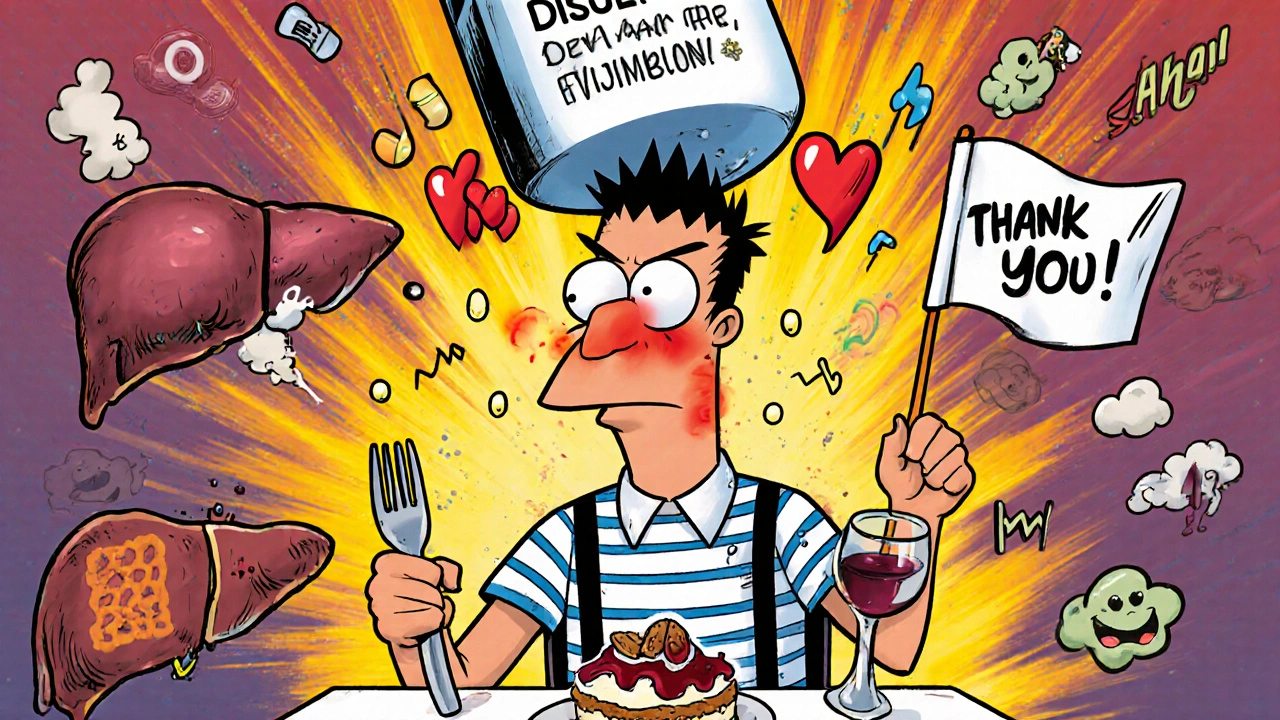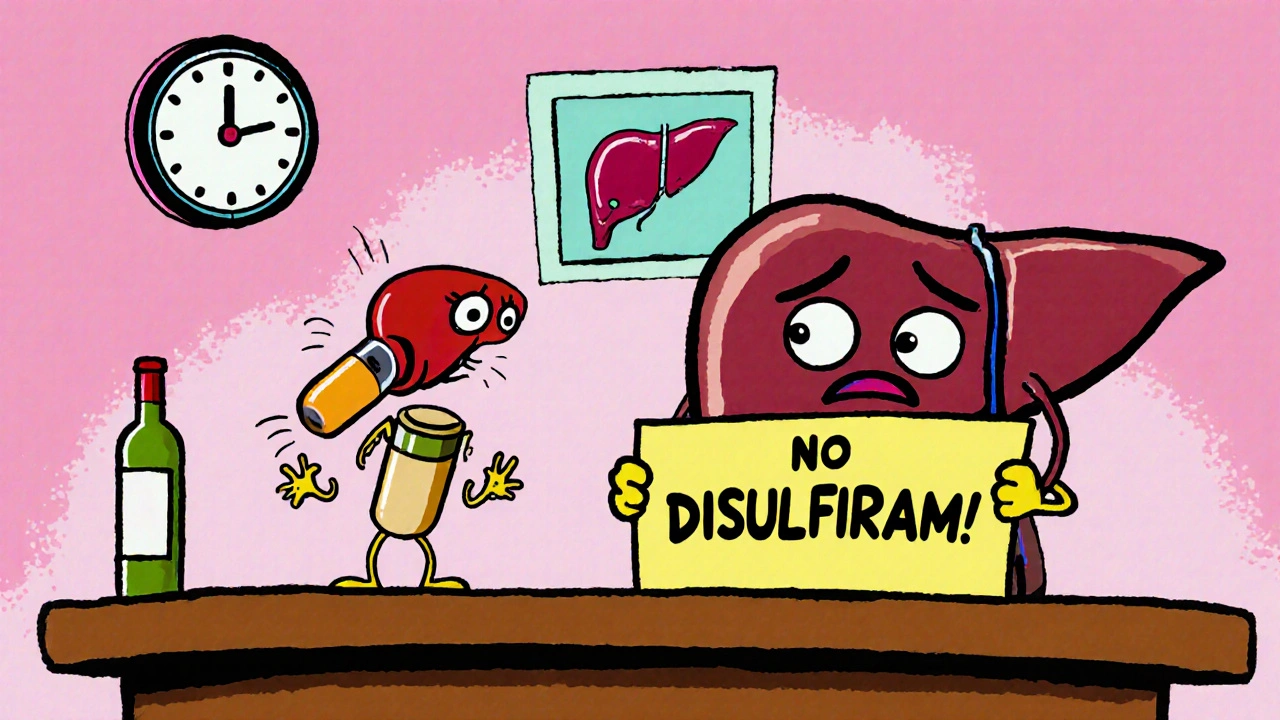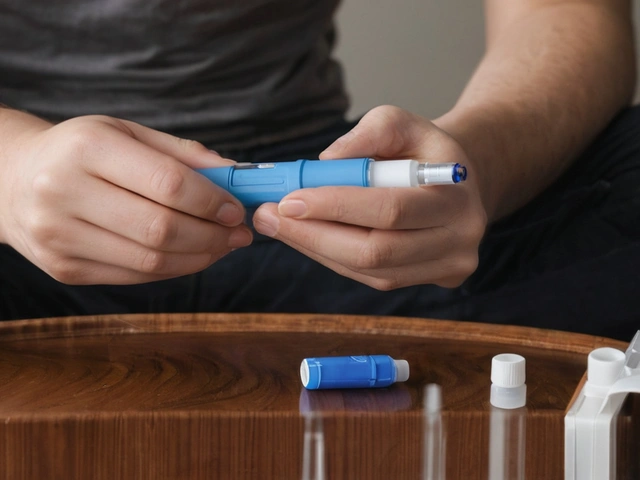Alcohol-induced liver disease (ALD) doesn’t just happen because someone drinks too much. It’s a slow, silent damage that builds over years-fatty liver, inflammation, scarring, and eventually cirrhosis. And while quitting alcohol is the only sure way to stop it, many people can’t do it alone. That’s where disulfiram comes in-not as a liver healer, but as a powerful tool to keep people from drinking in the first place.
What disulfiram actually does
Disulfiram isn’t a drug that fixes damaged liver cells. It doesn’t reduce inflammation or reverse fibrosis. Instead, it works by making alcohol physically unpleasant to consume. When someone takes disulfiram and then drinks alcohol, their body can’t break down acetaldehyde-a toxic byproduct of alcohol metabolism. That leads to a buildup of acetaldehyde in the blood, triggering symptoms like flushing, nausea, vomiting, rapid heartbeat, and dizziness. These reactions start within minutes and can last for hours.
This isn’t punishment. It’s a behavioral deterrent. The goal is simple: if drinking makes you feel awful, you’re less likely to do it. Studies show that when patients take disulfiram consistently, their rate of alcohol relapse drops by 50% or more compared to those on placebo. That’s not magic-it’s chemistry turned into a survival strategy.
Why this matters for liver disease
The liver can regenerate. Even in early-stage ALD, stopping alcohol can reverse fatty liver in weeks. In mild alcoholic hepatitis, abstinence leads to improvement in 80% of cases within six months. But if someone keeps drinking-even a little-the damage keeps piling up. One study from the University of California found that patients with ALD who drank just one drink per day after diagnosis had a 3.5 times higher risk of progressing to cirrhosis than those who stopped completely.
Disulfiram doesn’t cure ALD. But it creates the space for the liver to heal. When patients stop drinking, liver enzymes like ALT and AST drop significantly within 2-4 weeks. In some cases, fibrosis scores improve over 12-18 months. Disulfiram gives people the time they need to rebuild habits, access counseling, and let their body repair itself.
Who benefits most from disulfiram
Disulfiram isn’t for everyone. It works best for people who are motivated to quit but struggle with willpower. Think of it like a seatbelt-it doesn’t prevent crashes, but it keeps you safe when you’re in a car you shouldn’t be driving.
Good candidates include:
- People diagnosed with early or moderate ALD who still drink
- Those who have tried to quit but relapsed multiple times
- Patients with strong social support systems (family or therapists who help with adherence)
- Individuals who understand the consequences of drinking while on disulfiram
It’s not recommended for people with severe liver failure (Child-Pugh Class C), active hepatitis, or psychiatric conditions like psychosis. It also shouldn’t be used if someone might stop taking it suddenly-because once disulfiram leaves the system, alcohol tolerance returns quickly, increasing overdose risk.

How it’s used in real practice
Doctors don’t just hand out disulfiram pills and hope for the best. Treatment starts with a careful evaluation. Patients are screened for liver function, mental health, and motivation. They’re also warned: never drink alcohol while taking it, even in mouthwash, cough syrup, or food cooked with wine.
The standard dose is 250 mg once daily, taken in the morning. Some patients start lower (125 mg) to test tolerance. Treatment usually begins in a supervised setting-like a clinic or detox center-so the first reaction can be managed safely. After that, many patients take it at home, but with strict monitoring.
Compliance is the biggest hurdle. Studies show only about 20-30% of patients stick with disulfiram for more than six months. That’s why it’s often paired with counseling. Cognitive behavioral therapy, motivational interviewing, and support groups like Alcoholics Anonymous all improve retention. One 2023 trial in Australia found that patients who received weekly counseling alongside disulfiram were four times more likely to remain abstinent after one year than those who took the drug alone.
Side effects and risks
Disulfiram is generally safe when used correctly. But it’s not harmless. Common side effects include drowsiness, metallic taste, headache, and skin rash. Rarely, it can cause liver toxicity itself-especially in people with pre-existing liver damage. That’s why regular blood tests are required every 4-6 weeks during treatment.
The biggest danger? Accidental alcohol exposure. A sip of beer, a dessert with alcohol, or even inhaling fumes from paint thinner can trigger a reaction. Some patients have been hospitalized after using hand sanitizer with ethanol. That’s why education is part of the treatment. Patients are given a list of hidden alcohol sources and told to check every product label.
There’s also a psychological risk. Some people feel trapped by the drug. The fear of a reaction can create anxiety, and in rare cases, lead to depression. That’s why mental health screening before and during treatment is critical.
Alternatives to disulfiram
Disulfiram isn’t the only option for alcohol dependence. Other medications include:
- Naltrexone: Blocks opioid receptors, reducing alcohol cravings. Better for people who still drink occasionally but want to cut back.
- Acamprosate: Helps stabilize brain chemistry after quitting. Best for people who’ve already stopped drinking and want to avoid relapse.
- Topiramate: An anti-seizure drug that also reduces alcohol use. Often used off-label.
Each has pros and cons. Naltrexone doesn’t cause a disulfiram-like reaction, so it’s safer for people with liver damage. But it doesn’t stop drinking as effectively if someone is highly motivated to drink. Disulfiram’s deterrent effect is stronger for people who need a hard stop.
For ALD specifically, disulfiram has an edge because it directly prevents the main cause of damage: alcohol. Naltrexone and acamprosate help with cravings, but they don’t make drinking physically dangerous. In ALD, that physical consequence matters.
Real-world success stories
In Perth, a 52-year-old man named Mark was diagnosed with alcoholic steatohepatitis in 2023. His liver enzymes were three times above normal. He’d tried to quit five times. His doctor prescribed disulfiram and connected him with a local addiction counselor.
At first, he skipped doses. But after accidentally drinking a glass of wine at a family dinner, he spent the next 4 hours sweating, shaking, and vomiting. He didn’t touch alcohol again. Twelve months later, his ALT levels returned to normal. A follow-up liver scan showed significant reduction in fat accumulation.
Mark didn’t get cured by a pill. He got the chance to heal because the pill made drinking impossible.
What patients should know before starting
If you or someone you know is considering disulfiram for alcohol-induced liver disease, here’s what you need to remember:
- It’s not a cure-it’s a tool to stop drinking.
- It only works if you take it every day.
- You must avoid all sources of alcohol-even non-beverage ones.
- Regular blood tests are non-negotiable.
- Pair it with counseling for the best chance of success.
- Don’t start it unless you’re ready to quit for good.
Disulfiram doesn’t fix the liver. But it stops the damage. And that’s the first step to recovery.
Can disulfiram repair liver damage?
No, disulfiram does not repair liver damage. It prevents further damage by making alcohol consumption physically unpleasant, which helps patients stop drinking. Once alcohol intake stops, the liver can begin to heal on its own-especially in early stages of alcohol-induced liver disease. Disulfiram’s role is behavioral, not regenerative.
How long does it take for disulfiram to start working?
Disulfiram begins working within 1-2 hours after ingestion and remains active in the body for up to 14 days after the last dose. This means even if you miss a dose, you’re still protected from alcohol for over a week. However, the deterrent effect only activates when alcohol is consumed. Consistent daily use ensures continuous protection.
Is disulfiram safe for people with cirrhosis?
Disulfiram is generally not recommended for people with advanced cirrhosis (Child-Pugh Class C). The liver’s ability to metabolize the drug is impaired, increasing the risk of toxicity. In moderate cirrhosis (Child-Pugh Class B), it may be used cautiously with close monitoring, but only if the patient is highly motivated and under strict medical supervision.
Can you drink alcohol after stopping disulfiram?
Yes, but with extreme caution. Disulfiram can remain active in the body for up to two weeks after the last dose. Drinking alcohol during this time can still trigger a dangerous reaction. Even after the drug is fully cleared, alcohol tolerance is lower than before treatment, increasing the risk of overdose. Most doctors advise complete and permanent abstinence for patients with alcohol-induced liver disease.
What happens if you forget to take disulfiram?
If you miss a dose, take it as soon as you remember-unless it’s close to your next scheduled dose. Skipping doses reduces protection and increases relapse risk. If you miss multiple days, your body may lose the deterrent effect, and drinking alcohol could become possible again. Always consult your doctor before restarting after a break.
Does disulfiram help with alcohol cravings?
Disulfiram does not directly reduce alcohol cravings. Its effect is based on fear of negative consequences, not neurochemical changes. For craving reduction, medications like naltrexone or acamprosate are more effective. Many patients benefit from combining disulfiram with these drugs or behavioral therapy to address both the physical deterrent and psychological urge to drink.
Disulfiram isn’t glamorous. It doesn’t come with flashy ads or celebrity endorsements. But for people with alcohol-induced liver disease, it’s one of the most effective tools we have to break the cycle of drinking-and give the liver a real chance to heal.

 How Antibiotics Treat Bladder Infections: What You Need to Know
How Antibiotics Treat Bladder Infections: What You Need to Know
 Methimazole Allergy: Symptoms and Management
Methimazole Allergy: Symptoms and Management
 Comparing Diabetes Medications: Rybelsus Versus Ozempic Explained by Expert Betul
Comparing Diabetes Medications: Rybelsus Versus Ozempic Explained by Expert Betul
 Abhigra vs Other Sildenafil Brands: Full Comparison
Abhigra vs Other Sildenafil Brands: Full Comparison
 The Role of Special Olympics in the Lives of People with Intellectual Disabilities
The Role of Special Olympics in the Lives of People with Intellectual Disabilities
Mike Laska
October 31, 2025 AT 02:30So let me get this straight - you’re telling me the only thing keeping someone from drinking is the fear of throwing up for hours while their heart tries to escape their chest? That’s not medicine, that’s a horror movie plot. And yet… it works. I’ve seen it. My cousin took this crap for a year after his liver started screaming. He didn’t get cured. He got scared straight. And now he’s alive. That’s more than most can say.
Disulfiram isn’t a cure. It’s a cage. And sometimes, when you’re drowning in your own choices, a cage is the only thing that saves you.
Alexa Apeli
November 2, 2025 AT 00:36This is such an important and well-articulated breakdown of disulfiram’s role in ALD management. 🌟 Thank you for highlighting that it’s not about ‘fixing’ the liver but creating the conditions for healing. I’ve worked in addiction recovery for over a decade, and I can’t tell you how many patients we’ve seen reverse early-stage fatty liver simply by stopping alcohol - with the help of disulfiram as a behavioral anchor. The data speaks for itself. 💙
Eileen Choudhury
November 2, 2025 AT 09:04OMG this post made me cry 😭 I used to work with a guy who was a walking ghost - liver enzymes through the roof, couldn’t hold a job, wife left him. Then he got disulfiram. First week? He drank a beer at a BBQ. Spoiler: he spent the night puking in a Walmart parking lot. Came back the next day, looked me in the eye, and said, ‘I don’t wanna die like this.’ He’s been sober for 3 years now. Works. Not magic. Just brutal honesty wrapped in chemistry. 🙌
Zachary Sargent
November 3, 2025 AT 05:16They say disulfiram makes you pay for every sip. But here’s the real truth - it doesn’t stop the craving. It just makes the consequence so violent you’d rather starve than drink. I’ve been on it. I know. It’s not about willpower. It’s about survival. And yeah, the metallic taste in your mouth every day? That’s the price of being alive tomorrow.
Also, avoid hand sanitizer. I learned that the hard way. Emergency room. Don’t be me.
Melissa Kummer
November 3, 2025 AT 18:11While disulfiram is not a regenerative agent, its efficacy as a deterrent in the context of alcohol-induced liver disease is empirically validated and clinically significant. The pharmacological mechanism-acetaldehyde accumulation-creates a conditioned aversion that, when paired with structured behavioral support, yields statistically meaningful reductions in relapse rates. I urge clinicians to consider this modality not as a last resort, but as a foundational intervention for motivated patients with early to moderate ALD.
andrea navio quiros
November 3, 2025 AT 20:49Disulfiram doesn't heal the liver the liver heals itself if you stop drinking the drug just makes stopping easier for some people who can't stop because their brain is broken not their willpower it's not punishment it's a buffer between the old self and the new one maybe we need more buffers not more shame
Pradeep Kumar
November 4, 2025 AT 05:33My uncle took this in Mumbai after his doctor said he had 2 years if he kept drinking. He didn’t believe it at first. Then one night he had a sip of whiskey at a wedding. He collapsed. Took him 3 days to recover. Now he teaches yoga to recovering addicts. He says disulfiram didn’t save him - it gave him time to save himself. 🙏
And yes, he still checks every sauce bottle. Even ketchup. 😅
Andy Ruff
November 5, 2025 AT 08:29Let’s be real - this is just chemical coercion wrapped in medical jargon. You’re not treating addiction, you’re turning people into prisoners of their own biology. What about the people who don’t respond? The ones who still drink and just suffer in silence? Where’s the compassion? Where’s the real therapy? This isn’t treatment, it’s punishment dressed up as science. And don’t even get me started on the fact that you’re telling people to avoid alcohol in toothpaste and hand sanitizer - that’s not medicine, that’s paranoia.
And yet… I know someone who’s alive because of it. So maybe I’m wrong. But I still don’t like it.
S Love
November 6, 2025 AT 06:28Excellent summary. One critical point often overlooked: disulfiram’s half-life extends beyond its dosing schedule, meaning even intermittent adherence provides residual protection. This is why consistent patient education - not just compliance - is paramount. Also, pairing it with motivational interviewing significantly improves long-term outcomes. The data from the Australian trial is particularly compelling. Well done.
Pritesh Mehta
November 7, 2025 AT 10:53Western medicine continues to rely on fear as a therapeutic tool while ignoring the root causes - poverty, trauma, colonial legacy, spiritual emptiness. Disulfiram is a Band-Aid on a severed artery. You think forcing someone to vomit after drinking solves anything? No. It just makes them more ashamed. In India, we have ayurvedic herbs, meditation, community-based sobriety circles - no chemicals, no fear, just dignity. Why do we export this toxic model to the rest of the world? Because it’s profitable. Not because it’s right.
Billy Tiger
November 9, 2025 AT 09:34Disulfiram is a joke. People who take it are weak. They can’t handle their own lives so they need a drug to make them afraid of alcohol. Meanwhile the real addicts - the ones who drink until they die without any meds - they’re the real men. This isn’t treatment it’s babysitting for grownups who can’t grow up. And don’t even get me started on the liver enzyme nonsense - if your liver is that damaged you should be dead already. Stop coddling people.
Mike Laska
November 10, 2025 AT 23:07And yet… the guy who drank the beer at the BBQ? He’s alive. The guy who didn’t take it? He’s in the ground. So yeah, maybe it’s fear. Maybe it’s coercion. But if fear keeps you from dying, then fear isn’t the enemy - silence is.
And Billy? You’re right. Some people are too far gone for this. But for the ones still fighting? This is the lifeline. Don’t hate the rope. Be glad someone threw it.